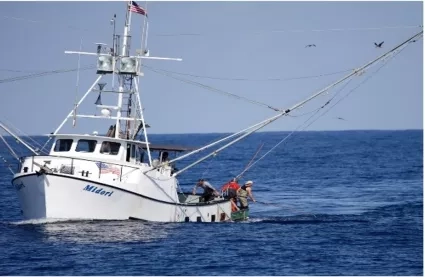As Earth’s oceans undergo dramatic changes, the spatial distributions of highly migratory species and fishing fleets are shifting in response to climate-driven changes, and there is growing concern of greater ecological and economic disruptions as climate impacts increase. New management and conservation frameworks are needed to consider how future climate impacts will affect the sustainability of fisheries worldwide. The FaCeT project team is focusing on developing products and applications that directly meet these management and conservation needs. This project addresses Sustainable Development Goal (SDG) 14 (Life Below Water) by utilizing Earth Observation data and in-situ data to understand the complex interactions between fisheries, marine species, and marine environments in US and international waters.
OUTPUTS & IMPACT
Development of a Fisheries Climate Toolkit (FaCeT) for use by US and International fishery resource managers (SDG 14.2 & 14.4)
FaCeT is a bi-coastal online platform that allows users to track fisheries-relevant physical and biological ocean features across multiple timescales to support climate-ready and sustainable fisheries. This toolkit will have products and applications that will allow users to visualize dynamic species and vessel distributions, tracking velocity and magnitude of change, changing fishing portfolios, and addressing and communicating climate uncertainty in fisheries. By providing new and easily interpreted knowledge about the future distributions of species and vessels into a cohesive toolkit, FaCeT will provide a wide range of forecasting applications to directly address the specific management challenges, needs, and priorities that US and international fisheries face in the context of climate variability and risk.
The toolkit utilizes in situ species observations environmental data to create dynamic models of species and vessel distributions (Figure 2). Historical and current data is analyzed to provide the most comprehensive understanding of fisheries over time, as well as to make projections about how marine species and fishing vessels will respond to climate changes.
The projection aspect of the toolkit is especially relevant to SDGs because it illustrates the longevity and adaptability of fisheries. These future models and recommendations highlight a viable path to sustainable fishery management, which is a crucial component of SDG 14. FaCeT is still in the development stage, but several key species and fishing fleets of interest have been identified for the tool to focus on. Swordfish, mako (Figure 1) and blue sharks, as well as yellowfin (Figure 1), bigeye, and skipjack tuna are the migratory species currently being looked at across the US. Additionally, models analyzing longline fleets as well as trolling fleets (Figure 3) have been integrated into the toolkit. Although FaCeT is not being used to report on SDGs, its applications to the future of fishery management are highly important and related to sustainability.
Engagement and outreach across the US and internationally (SDG 14.2 & 14.4)
Although the project is based in the US, stakeholder outreach extends beyond US borders to organizations such as the Inter-American Tropical Tuna Conservation (IATTC). As for domestic engagement, FaCeT has established partnerships with major organizations such as the Ocean Conservancy, Global Fishing Watch, and the National Oceanic and Atmospheric Administration (NOAA). The majority of FaCeT stakeholders come from government or academia and research, with the rest coming from non-profits, businesses, and regional fisheries management organizations. Despite COVID challenges, the project held one on one meetings with stakeholders as well as seminars and presentations at AGU, AFS, Ocean Science Meeting, and with NASA. The team has also held seminars out of NASA, the University of California, Davis, and Moss Landing Laboratories.



